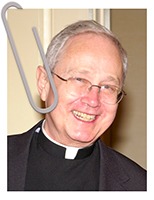Have you ever had someone put words into your mouth? I suspect all of us have at times felt annoyed at someone putting words in our mouths.
At the same time, I suspect that there have been other times that we have felt grateful that someone else put into words what I was feeling. “I could not have said it better”.
The former is often rooted in an inability to hear what another person is saying. The latter is the fruit of listening with what therapists call the “third” or inner ear”.
The eyes … and ears… of an artist
Almost exactly 20 years ago Bro. Mark Elder, CM, alias “Buffalo Bro”, and I crossed paths in Rome. I was present at the creation of a series of murals he was painting in the foyer of the offices of our International Curia in Rome.
There are two things I learned from him – artists see … because they listen.
While there I had the privilege of visiting the Vatican Museum of Modern Art with him. I had been to the museum many times before. This time, as we walked, sat, and looked, it was like I had never been there before. I saw so much for the first time! His insightful commentary helped me realize how much I had been “seeing but not seeing.” I have since realized I really did not know how to see. Or should I say, how to focus and on what.
I also did not know until much later how much listening Mark did to the members of the Curia before he chose the theme and painted the murals with their help. He asked a series of questions about what they hoped someone entering their foyer would immediately sense about Vincentians.
As they spoke about the 5 Vincentian Virtues and their role in the world he saw “The Gleaners”, a classic painting by Millet. It depicts three peasant women gleaning a field of stray stalks of wheat left behind after the harvest. For him, it seemed to capture the way they were going out to those on the margins of society.
I realized how closely he listened and saw what they were saying.
He listened closely and “saw” what was important to people in the Curia. In all his wall- and building-sized murals since then he continues to listen deeply and involve the people he serves in the actual work of creating an expression of what is important to them. Through their involvement, it becomes “their own words”. (For more details see his article “The Case for Community Supported Public Art as a Vincentian Ministry )
Ministry lessons from an artist
I never thought of artists teaching others key principles of ministry. But I do now. I also see how Vincent lived these principles.
What did Vincent do? He first listened deeply to the cries of suffering people. He then helped them give voice to their cries in many different ways. Wherever he could he involved them in ministry for themselves and others. Vincent’s canvas and oils were his gifts for helping people to see what they had not seen. With his genius for organizing he involved them in solutions.
We talk of systemic change today. We can not foster true change until we listen deeply. Then we draw on our knowledge and contacts to help them tell their story and discover better ways to help them address the issues that are important to them.
Our eyes and ears…
- How well do I listen and understand the cries of the marginalized?
- How well do I help them find their own voice?
- What is the difference between “being the voice of the poor” and giving them a voice?
PS See an earlier famvin.org article on how he relates art and spirituality
For an audio version of the Vincentian Mindwalk click below


Scott Peck, in his work “Different Drum: Community making and peace”, describes true listening as a process the begins with a false notion of agreement, enters chaos as I try to force you to change, becomes depression when I realize I cannot force you to change and, by passing through this death, finds the ability to listen. I usually get stuck in the second piece of inciting chaos…..
Interesting reflection, Father. It reminded me of a time when I was in the corporate world in the maintenance management department and my boss had a “vision” of what she wanted to accomplish through a database system. The first attempt of communicating that to a programmer failed miserably. When I came on board, I had enough experience working with databases to “speak the language” that a programmer could translate into code and a program.
Your insight also helped me realize that those we visit in need sometimes don’t speak the same language that those who can help them and they need persons to interpret that need to better accomplish what they need. We use the term “advocate” but that’s best defined as listening, understanding and putting into concrete terms for the appropriate action.
It takes your artist’s eyes and hears to learn how to make that happen. So often, it truly does.
Another thought from that same corporation but from a different boss. He constantly reminded me, “Don’t put ‘No’ in someone else’s mouth.” He meant you might “think” you know how they’ll react to something, but let them make the call. They might surprise you. The Fr Bill Pelletier remark about tossing an idea to a pastor, “No doesn’t always mean No. Sometimes it means, not right now.”